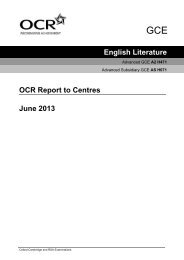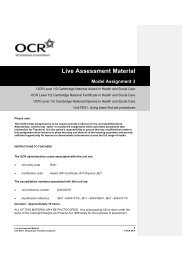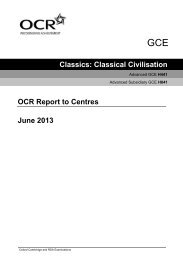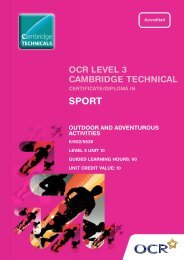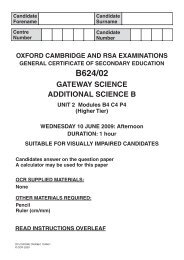Unit F389 - Comic drama in the ancient world - Specimen - OCR
Unit F389 - Comic drama in the ancient world - Specimen - OCR
Unit F389 - Comic drama in the ancient world - Specimen - OCR
You also want an ePaper? Increase the reach of your titles
YUMPU automatically turns print PDFs into web optimized ePapers that Google loves.
SPECIMEN<br />
Advanced GCE<br />
GCE CLASSICS<br />
<strong>Unit</strong> CC9: <strong>Comic</strong> Drama <strong>in</strong> <strong>the</strong> Ancient World<br />
<strong>F389</strong> QP<br />
<strong>Specimen</strong> Paper Morn<strong>in</strong>g/Afternoon<br />
Additional Materials: Answer Booklet (12 pages)<br />
INSTRUCTIONS TO CANDIDATES<br />
• Answer one question from Section A and one question from Section B.<br />
INFORMATION FOR CANDIDATES<br />
Time: 2 hours<br />
• The number of marks for each question is given <strong>in</strong> brackets [ ] at <strong>the</strong> end of each question or part<br />
question.<br />
• The total number of marks for this paper is 100.<br />
ADVICE TO CANDIDATES<br />
• Read each question carefully and make sure you know what you have to do before start<strong>in</strong>g your<br />
answer.<br />
SPECIMEN<br />
This document consists of 6 pr<strong>in</strong>ted pages.<br />
SP (SLM) T12103 © <strong>OCR</strong> 2007 QAN 500/2596/X <strong>OCR</strong> is an exempt Charity [Turn Over
2<br />
Answer one question from Section A and one question from Section B.<br />
Section A: Commentary Questions<br />
Answer ei<strong>the</strong>r Question 1 or Question 2.<br />
You are rem<strong>in</strong>ded that marks are awarded for <strong>the</strong> quality of written communication of<br />
your answer.<br />
1 Read <strong>the</strong> passage and answer <strong>the</strong> questions.<br />
LAMPITO: Guid, <strong>the</strong>n we’ll see that our men mak peace and keep it faithfully. But this<br />
A<strong>the</strong>nian riff-raff [<strong>in</strong>dicat<strong>in</strong>g <strong>the</strong> audience] – how will ye ever <strong>in</strong>duce <strong>the</strong>m tae see sense?<br />
LYSISTRATA: We will, you’ll see.<br />
LAMPITO: Not sae lang as <strong>the</strong>ir warrships have feet and <strong>the</strong>y have that bottomless fund o’<br />
money <strong>in</strong> A<strong>the</strong>na’s temple.<br />
LYSISTRATA: Oh, don’t th<strong>in</strong>k we haven’t thought about that! We’re go<strong>in</strong>g to occupy <strong>the</strong><br />
Acropolis today. While we take care of our side of th<strong>in</strong>gs, all <strong>the</strong> older women have been<br />
<strong>in</strong>structed to seize <strong>the</strong> Acropolis under pretence of go<strong>in</strong>g to make sacrifices.<br />
LAMPITO: A guid notion; it soonds as if it will worrk.<br />
LYSISTRATA: Well <strong>the</strong>n, Lampito, why don’t we well and truly confirm <strong>the</strong> whole th<strong>in</strong>g now<br />
by tak<strong>in</strong>g an oath?<br />
LAMPITO: Pit <strong>the</strong> aith to us and we’ll sweir.<br />
LYSISTRATA: Well spoken. [Call<strong>in</strong>g <strong>in</strong>to <strong>the</strong> house] Scythaena!<br />
[A SLAVE-GIRL comes outside; she is carry<strong>in</strong>g a large round w<strong>in</strong>e-bowl. She stares openeyed<br />
about her.] What are you star<strong>in</strong>g at? Put that shield face down <strong>in</strong> front of us. [The<br />
SLAVE-GIRL lays <strong>the</strong> bowl on <strong>the</strong> ground.]. Now someone give me <strong>the</strong> limbs of <strong>the</strong><br />
sacrificial victim.<br />
MYRRHINE: Lysistrata, what sort of oath is this you’re giv<strong>in</strong>g us to take?<br />
LYSISTRATA: Why, <strong>the</strong> one that Aeschylus talks about somewhere - fill<strong>in</strong>g a shield with<br />
sheep’s blood.<br />
MYRRHINE: But Lysistrata, you can’t take a peace oath over a shield!<br />
LYSISTRATA: What do you suggest, <strong>the</strong>n?<br />
MYRRHINE: Suppose we got a white stallion and cut it up?<br />
LYSISTRATA: White stallion <strong>in</strong>deed!<br />
MYRRHINE: Well, how are we go<strong>in</strong>g to take <strong>the</strong> oath, <strong>the</strong>n?<br />
CALONICE: I’ve got an idea, if you like. Stand a large black cup on <strong>the</strong> ground, pour <strong>in</strong> <strong>the</strong><br />
blood of some Thasos grapes, and swear – to put no water <strong>in</strong> <strong>the</strong> cup.<br />
LAMPITO: Och aye, that’s <strong>the</strong> k<strong>in</strong>d of aith I like!<br />
LYSISTRATA [to Scythaena]: A cup and a w<strong>in</strong>e-jar from <strong>in</strong>side, please.<br />
[SCYTHAENA takes her bowl <strong>in</strong>side and returns with a cup and jar, both of enormous<br />
size. The women crowd round.]<br />
MYRRHINE: My dears, isn’t it a whopper?<br />
CALONICE [pick<strong>in</strong>g up <strong>the</strong> cup]: Cheers you up even to touch it!<br />
LYSISTRATA: Put <strong>the</strong> cup down [CALONICE does so] and take hold of <strong>the</strong> sacrificial victim.<br />
[She holds up <strong>the</strong> jar; all <strong>the</strong> women lay a hand on it.] O mighty goddess of Persuasion,<br />
and thou, O Lady of <strong>the</strong> Lov<strong>in</strong>g Cup, accept this sacrifice and look with favour on<br />
womank<strong>in</strong>d.<br />
SPECIMEN<br />
From Lysistrata and o<strong>the</strong>r plays by Aristophanes, translated by Alan Sommerste<strong>in</strong>, Pengu<strong>in</strong> Classics<br />
5<br />
10<br />
15<br />
20<br />
25<br />
30<br />
35<br />
(a)<br />
What targets of Aristophanes’ satire can you identify <strong>in</strong> this passage? How typical are <strong>the</strong>y<br />
of <strong>the</strong> aspects of A<strong>the</strong>nian society which Aristophanes makes fun of elsewhere <strong>in</strong> <strong>the</strong> plays<br />
you have studied? [25]<br />
(b) How dom<strong>in</strong>ant is Lysistrata <strong>in</strong> this passage and <strong>the</strong> rest of <strong>the</strong> play? [25]
3<br />
Do not answer Question 2 if you have already answered Question 1.<br />
You are rem<strong>in</strong>ded that marks are awarded for <strong>the</strong> quality of written communication of<br />
your answer.<br />
2 Read <strong>the</strong> passage and answer all <strong>the</strong> questions at <strong>the</strong> end.<br />
CALIDORUS: Well, aren’t you go<strong>in</strong>g to help me?<br />
PSEUDOLUS: What can I do?<br />
CALIDORUS: Ah me!<br />
PSEUDOLUS: You can save your ‘ah me’s’. I can do that much.<br />
CALIDORUS: I’m lost. I don’t know where to borrow any money.<br />
PSEUDOLUS: Ah me!<br />
CALIDORUS: And I haven’t a penny of my own.<br />
PSEUDOLUS: Ah me!<br />
CALIDORUS: And tomorrow that man will take <strong>the</strong> girl away.<br />
PSEUDOLUS: Ah me!<br />
CALIDORUS: Is that all you can do to help me?<br />
PSEUDOLUS: It’s all I’ve got, sir. I’ve got a pile of ‘ah me’s’ put away <strong>in</strong> my money-box.<br />
CALIDORUS: But I’m desperate. Can’t you lend me a s<strong>in</strong>gle drachma? I’ll pay you back<br />
tomorrow.<br />
PSEUDOLUS: By God, I couldn’t raise a drachma, not even if I pawned my own body. But<br />
what do you want to do with a drachma?<br />
CALIDORUS: Buy a rope.<br />
PSEUDOLUS: What for?<br />
CALIDORUS: To hang myself. I am resolved before night falls to take refuge <strong>in</strong> everlast<strong>in</strong>g<br />
night.<br />
PSEUDOLUS: Then who’ll pay me back my drachma? Is that your idea, to go and hang<br />
yourself on purpose to do me out of a drachma if I lend you one?<br />
CALIDORUS: I tell you I cannot live if she is taken from me and carried off.<br />
PSEUDOLUS: There’s noth<strong>in</strong>g to cry about, you silly cuckoo. You’ll live.<br />
CALIDORUS: Noth<strong>in</strong>g to cry about – when I can’t raise a drachma, not know where <strong>in</strong> <strong>the</strong><br />
<strong>world</strong> to turn for a piece of silver?<br />
PSEUDOLUS: Well, it’s silver tears you’ll have to weep, as I understand it from this letter.<br />
You might as well try to catch ra<strong>in</strong> <strong>in</strong> a sieve, for all <strong>the</strong> good <strong>the</strong> tears you’re shedd<strong>in</strong>g now<br />
can do you. But cheer up; I’ll never desert a master <strong>in</strong> love. Somewhere or o<strong>the</strong>r, before<br />
<strong>the</strong> day’s out, by hook or crook – or by this hand – I th<strong>in</strong>k I can f<strong>in</strong>d you some pecuniary<br />
assistance. Where it’s com<strong>in</strong>g from I can’t exactly say at <strong>the</strong> moment; but it will come, that’s<br />
all I know; I know by <strong>the</strong> twitch of this eyebrow.<br />
CALIDORUS: Heaven send you’ll be as good as your word.<br />
PSEUDOLUS: Lord love you, you know what I can do when I wave my magic wand, what a<br />
dust I can stir up when I set about it.<br />
CALIDORUS: All my hope of life rests on you.<br />
PSEUDOLUS: Suppose I promise to get your girl back for you today or give you two<br />
thousand drachmas – how will that do?<br />
CALIDORUS: It’ll do very well, if you can do it?<br />
PSEUDOLUS: Ask me for two thousand, <strong>the</strong>n – <strong>in</strong> proper form, so that <strong>the</strong>re’ll be no doubt<br />
what I’m promis<strong>in</strong>g. Go on, ask me, please; I’m dy<strong>in</strong>g to promise it.<br />
CALIDORUS: Will you give me two thousand drachmas today?<br />
PSEUDOLUS: I will. Now don’t say ano<strong>the</strong>r word. One th<strong>in</strong>g I warn you, though – so don’t<br />
say I didn’t tell you – if all else fails, I shall have to touch your fa<strong>the</strong>r for it.<br />
CALIDORUS: Heaven bless you and keep you m<strong>in</strong>e for ever! But … as a dutiful son … I feel<br />
bound to say – why not try my mo<strong>the</strong>r too?<br />
PSEUDOLUS: Leave it all to me, and you can sleep sound, on whichever eye you like.<br />
CALIDORUS: Whichever eye? Don’t you mean ear?<br />
SPECIMEN<br />
5<br />
10<br />
15<br />
20<br />
25<br />
30<br />
35<br />
40<br />
45<br />
[Turn over
4<br />
PSEUDOLUS: I like to vary <strong>the</strong> common expressions. [He proclaims to <strong>the</strong> audience] Now let<br />
all take notice – and let none say he has not received notice – all adults here present, all<br />
citizens of this city, all friends and acqua<strong>in</strong>tances of m<strong>in</strong>e, are hereby warned and advised,<br />
this day … to be on <strong>the</strong>ir guard … aga<strong>in</strong>st me … and not to trust a word I say.<br />
50<br />
From Plautus: The Pot of Gold and o<strong>the</strong>r plays, translated by E.F. Watl<strong>in</strong>g, Pengu<strong>in</strong> Classics<br />
(a)<br />
(b)<br />
Compare <strong>the</strong> relationship between Calidorus and Pseudolus <strong>in</strong> this passage with that<br />
between Dionysus and Xanthias <strong>in</strong> Act 1 of Frogs. [25]<br />
Discuss whe<strong>the</strong>r ‘cunn<strong>in</strong>g slave’ is a sufficient description of <strong>the</strong> character of Pseudolus <strong>in</strong><br />
this passage and throughout <strong>the</strong> play. [25]<br />
Section A Total [50]<br />
SPECIMEN
5<br />
Section B: Essays<br />
Answer one question.<br />
You are rem<strong>in</strong>ded that marks are awarded for <strong>the</strong> quality of written communication of<br />
your answer.<br />
3 In your op<strong>in</strong>ion, which of <strong>the</strong> authors you have studied uses <strong>the</strong> greatest variety of comic<br />
techniques? In your answer you must <strong>in</strong>clude discussion of all three authors. [50]<br />
4 ‘Aristophanes had more important messages for his audience than Menander and Plautus did<br />
for <strong>the</strong>irs.’ To what extent do you agree with this statement? [50]<br />
Section B Total [50]<br />
Paper Total [100]<br />
SPECIMEN
6<br />
Copyright Acknowledgements:<br />
Sources<br />
1. From Lysistrata and o<strong>the</strong>r plays by Aristophanes, translated by Alan Sommerste<strong>in</strong>. Pengu<strong>in</strong> Classics, 1991 pp168-200<br />
2. From Plautus: The Pot of Gold and o<strong>the</strong>r plays, translated by E.F, Watl<strong>in</strong>g, Pengu<strong>in</strong> Classics, 1965, pp 74-125<br />
Permission to reproduce items where third-party owned material protected by copyright is <strong>in</strong>cluded has been sought and<br />
cleared where possible. Every reasonable effort has been made by <strong>the</strong> publisher (<strong>OCR</strong>) to trace copyright holders, but if<br />
any items requir<strong>in</strong>g clearance have unwitt<strong>in</strong>gly been <strong>in</strong>cluded, <strong>the</strong> publisher will be pleased to make amends at <strong>the</strong> earliest<br />
opportunity.<br />
<strong>OCR</strong> is part of <strong>the</strong> Cambridge Assessment Group. Cambridge Assessment is <strong>the</strong> brand name of University of Cambridge<br />
Local Exam<strong>in</strong>ations Syndicate (UCLES), which is itself a department of <strong>the</strong> University of Cambridge.<br />
© <strong>OCR</strong> 2007<br />
SPECIMEN
OXFORD CAMBRIDGE AND RSA EXAMINATIONS<br />
Advanced GCE<br />
GCE CLASSICS<br />
<strong>Unit</strong> CC9: <strong>Comic</strong> Drama <strong>in</strong> <strong>the</strong> Ancient World<br />
<strong>Specimen</strong> Mark Scheme<br />
The maximum mark for this paper is 100.<br />
SPECIMEN<br />
<strong>F389</strong> MS<br />
This document consists of 10 pr<strong>in</strong>ted pages.<br />
SP (SLM) T12103 © <strong>OCR</strong> 2007 QAN 500/2596/X <strong>OCR</strong> is an exempt Charity [Turn Over
2<br />
Section A<br />
Question<br />
Number<br />
Answer<br />
Max<br />
Mark<br />
Answers must be marked us<strong>in</strong>g <strong>the</strong> level descriptors <strong>in</strong> <strong>the</strong> mark<strong>in</strong>g grids<br />
and a mark awarded for each Assessment Objective. The follow<strong>in</strong>g po<strong>in</strong>ts<br />
are <strong>in</strong>dicative and offer question specific guidance. They do not provide<br />
an exhaustive list and any relevant po<strong>in</strong>ts should be credited.<br />
1 Read <strong>the</strong> passage and answer <strong>the</strong> questions.<br />
1(a) What targets of Aristophanes’ satire can you identify <strong>in</strong> this<br />
passage? How typical are <strong>the</strong>y of <strong>the</strong> aspects of A<strong>the</strong>nian society<br />
which Aristophanes makes fun of elsewhere <strong>in</strong> <strong>the</strong> plays you have<br />
studied?<br />
Candidates should be able to identify such features as:<br />
Political satire:<br />
• here Lampito makes cynical remarks about A<strong>the</strong>nian ‘riff-raff’ (<strong>the</strong><br />
audience, of course!) and alludes to A<strong>the</strong>ns’ amass<strong>in</strong>g of Delian<br />
League money;<br />
• elsewhere <strong>the</strong>re are many examples: expect reference to Procleon<br />
and <strong>the</strong> Wasps as manipulated by <strong>the</strong> demagogues and to <strong>the</strong> failure<br />
of <strong>the</strong> politicians implicit <strong>in</strong> much of Frogs and made explicit <strong>in</strong> <strong>the</strong><br />
parabasis;<br />
Religious satire:<br />
• here <strong>the</strong>re is <strong>the</strong> parody of a sacrifice, with <strong>the</strong> Freudian white stallion,<br />
<strong>the</strong> w<strong>in</strong>e for dr<strong>in</strong>k<strong>in</strong>g ra<strong>the</strong>r than pour<strong>in</strong>g and <strong>the</strong> unorthodox<br />
recipients of <strong>the</strong> prayers at <strong>the</strong> end;<br />
• elsewhere <strong>the</strong>re is <strong>the</strong> debunk<strong>in</strong>g of Dionysus and Heracles and of<br />
Hades <strong>in</strong> Frogs;<br />
Satire on women:<br />
• here <strong>the</strong>y are obsessed by dr<strong>in</strong>k and sex. Myrrh<strong>in</strong>e disguises <strong>the</strong> w<strong>in</strong>e<br />
as ‘<strong>the</strong> blood of some Thasos grapes’. The ‘whopper’ <strong>in</strong>nuendo is<br />
clear;<br />
• also <strong>in</strong> Lysistrata we see <strong>the</strong> women’s desperate (and foolish)<br />
attempts to escape from <strong>the</strong> Acropolis. In Wasps women are sexual<br />
objects – Harvest and <strong>the</strong> abducted flute girl <strong>in</strong> particular come <strong>in</strong> for<br />
some rough treatment. The landladies <strong>in</strong> Frogs are perhaps a comic<br />
stereotype;<br />
• Better answers should identify o<strong>the</strong>r areas of A<strong>the</strong>nian life that<br />
Aristophanes makes fun of, such as <strong>the</strong> feebleness of men (eg <strong>the</strong><br />
chorus and <strong>the</strong> Magistrate) <strong>in</strong> Lysistrata and <strong>the</strong> foibles of <strong>the</strong><br />
<strong>drama</strong>tists <strong>in</strong> Frogs. [25]<br />
SPECIMEN
3<br />
Section A<br />
Question<br />
Number<br />
Answer<br />
Max<br />
Mark<br />
1(b)<br />
How dom<strong>in</strong>ant is Lysistrata <strong>in</strong> this passage and <strong>the</strong> rest of <strong>the</strong> play?<br />
Lysistrata is a dom<strong>in</strong>ant figure because:<br />
• <strong>in</strong> <strong>the</strong> passage she comes up with <strong>the</strong> two-pronged scheme, bosses<br />
<strong>the</strong> slave girl, <strong>in</strong>itiates <strong>the</strong> oath-tak<strong>in</strong>g and leads <strong>the</strong> prayers at <strong>the</strong><br />
end;<br />
• she has already assembled <strong>the</strong> women from various states and won<br />
over <strong>the</strong> doubters;<br />
• she has <strong>the</strong> wit to hold on to <strong>the</strong> hostages when Lampito goes back to<br />
Sparta;<br />
• she dom<strong>in</strong>ates <strong>the</strong> agon with <strong>the</strong> Magistrate, with her wool analogy<br />
and her dress<strong>in</strong>g of him as a corpse;<br />
• she foils <strong>the</strong> escape attempts from <strong>the</strong> Acropolis, confirm<strong>in</strong>g <strong>the</strong>ir<br />
stance with an improvised oracle;<br />
• she achieves <strong>the</strong> f<strong>in</strong>al rapprochement with <strong>the</strong> help of <strong>the</strong> seductive<br />
personification of Reconciliation, conduct<strong>in</strong>g <strong>the</strong> peace agreement<br />
and lead<strong>in</strong>g both sides <strong>in</strong>to <strong>the</strong> celebration.<br />
Better answers will be able to add occasions where her dom<strong>in</strong>ance slips<br />
a little:<br />
• she is not very decisive when her shield <strong>in</strong>itiative is rejected <strong>in</strong> <strong>the</strong><br />
passage;<br />
• she plays no part <strong>in</strong> <strong>the</strong> <strong>in</strong>itial confrontation between <strong>the</strong> two<br />
choruses;<br />
• perhaps surpris<strong>in</strong>gly she is not <strong>the</strong> dom<strong>in</strong>ant figure <strong>in</strong> <strong>the</strong> sem<strong>in</strong>al (or<br />
not!) scene of <strong>the</strong> frustrated husband, although she does act as<br />
Myrrh<strong>in</strong>e’s tra<strong>in</strong>er and extracts a bribe from C<strong>in</strong>esias. [25]<br />
2 Read <strong>the</strong> passage and answer <strong>the</strong> questions.<br />
2(a) Compare <strong>the</strong> relationship between Calidorus and Pseudolus <strong>in</strong> this<br />
passage with that between Dionysus and Xanthias <strong>in</strong> Act 1 of Frogs.<br />
There are some basic similarities that candidates should be able to<br />
identify:<br />
• <strong>the</strong>y are both master/slave relationships;<br />
• <strong>in</strong> both <strong>the</strong> slave is <strong>the</strong> more forceful and confident member, and thus<br />
supplies more of <strong>the</strong> humour;<br />
• <strong>in</strong> both <strong>the</strong> master is more diffident;<br />
• <strong>the</strong> slave makes fun of <strong>the</strong> master <strong>in</strong> a way <strong>in</strong>conceivable <strong>in</strong> real life.<br />
In <strong>the</strong> passage Pseudolus:<br />
• adopts Calidorus’ ‘ah me’ and claims to have a treasury of <strong>the</strong>m;<br />
SPECIMEN
4<br />
Section A<br />
Question<br />
Number<br />
Answer<br />
Max<br />
Mark<br />
2 (a)<br />
cont’d<br />
2(b)<br />
• makes fun of <strong>the</strong> <strong>in</strong>tended suicide by say<strong>in</strong>g he won’t back <strong>the</strong><br />
drachma for <strong>the</strong> rope which he hasn’t <strong>in</strong> any case got to lend;<br />
• cheeks his master (call<strong>in</strong>g him ‘silly cuckoo’ and manipulat<strong>in</strong>g him <strong>in</strong>to<br />
ask<strong>in</strong>g nicely for <strong>the</strong> money);<br />
• is pompous <strong>in</strong> his use of language (‘pecuniary assistance’) and ra<strong>the</strong>r<br />
bizarre (‘I like to vary <strong>the</strong> common expressions’ and <strong>the</strong> fact that he<br />
makes a f<strong>in</strong>al proclamation – which conta<strong>in</strong>s a warn<strong>in</strong>g aga<strong>in</strong>st<br />
himself!).<br />
By comparison Calidorus:<br />
• is ra<strong>the</strong>r foppish (note <strong>the</strong> poetic turn of phrase ‘to take refuge <strong>in</strong><br />
everlast<strong>in</strong>g night’);<br />
• has a melo<strong>drama</strong>tic disposition (go<strong>in</strong>g to hang himself for unrequited<br />
love).<br />
In Frogs:<br />
• Dionysus is similarly obsessed – with a passion for Euripides;<br />
• he too is un<strong>world</strong>ly (literally!) and immediately seen as a figure of fun<br />
because of his bizarre costume;<br />
• Xanthias shows a quick wit (of <strong>the</strong> speak<strong>in</strong>g corpse ‘he’ll come to a<br />
bad end’);<br />
• he teases Dionysus with his monster/beautiful girl/monster rout<strong>in</strong>e;<br />
• similarly he is always one step ahead of his master <strong>in</strong> <strong>the</strong> change of<br />
identity scene, conclud<strong>in</strong>g with his ability to outdo Dionysus <strong>in</strong> pa<strong>in</strong><br />
tolerance. [25]<br />
Discuss whe<strong>the</strong>r ‘cunn<strong>in</strong>g slave’ is a sufficient description of <strong>the</strong><br />
character of Pseudolus <strong>in</strong> this passage and throughout <strong>the</strong> play.<br />
There are clearly occasions where Pseudolus is cunn<strong>in</strong>g but better<br />
answers will have to assert that he has o<strong>the</strong>r characteristics as well.<br />
It is not his cunn<strong>in</strong>g that dom<strong>in</strong>ates <strong>the</strong> early stages:<br />
• he declares himself as Calidorus’ chief confidante (‘money, service or<br />
advice, all I have is at your disposal’);<br />
• he makes fun of his master (as <strong>in</strong> <strong>the</strong> passage and when he reads out<br />
his letter);<br />
• he stands up to Ballio (plead<strong>in</strong>g for time for Calidorus to get <strong>the</strong><br />
money for <strong>the</strong> girl and show<strong>in</strong>g a good l<strong>in</strong>e <strong>in</strong> <strong>in</strong>vective).<br />
So far he really has no plan for action, but <strong>the</strong>n he:<br />
• is able to persuade Simo to give him money to get <strong>the</strong> girl away from<br />
Ballio (even if he doesn’t know how he’s go<strong>in</strong>g to do it);<br />
• pretends to be Ballio’s ‘sub-Ballio’, makes up a false name and gets<br />
hold of <strong>the</strong> sealed letter;<br />
• arranges for Simia (Char<strong>in</strong>us’ slave) to take <strong>the</strong> seal and 500<br />
drachmas to Ballio pretend<strong>in</strong>g to be Harpax;<br />
• his f<strong>in</strong>al significant contribution reflects not his cunn<strong>in</strong>g but his<br />
drunken triumph and his humiliation of Simo. [25]<br />
Section A Total [50]<br />
SPECIMEN
5<br />
Section B<br />
Question<br />
Number<br />
Answer<br />
Max<br />
Mark<br />
Answers must be marked us<strong>in</strong>g <strong>the</strong> level descriptors <strong>in</strong> <strong>the</strong> mark<strong>in</strong>g grids<br />
and a mark awarded for each Assessment Objective. The follow<strong>in</strong>g po<strong>in</strong>ts<br />
are <strong>in</strong>dicative and offer question specific guidance. They do not provide<br />
an exhaustive list and any relevant po<strong>in</strong>ts should be credited.<br />
3 In your op<strong>in</strong>ion, which of <strong>the</strong> authors you have studied uses <strong>the</strong><br />
greatest variety of comic techniques? In your answer you must<br />
<strong>in</strong>clude discussion of all three authors.<br />
Candidates will almost certa<strong>in</strong>ly opt for Aristophanes but will need to<br />
discuss <strong>the</strong> o<strong>the</strong>r authors as required by <strong>the</strong> question rubric. They will<br />
need to give detailed examples of techniques quoted <strong>in</strong> order to ga<strong>in</strong> AO1<br />
marks.<br />
Aristophanes’ work is characterised by:<br />
• spectacle (choruses of frogs and wasps, escape attempts from a<br />
netted house, old men be<strong>in</strong>g drenched with water, exaggerated<br />
costumes and props);<br />
• bizarre plot items (a trial of dogs, women occupy <strong>the</strong> Acropolis, a god<br />
dressed as ano<strong>the</strong>r god goes down to Hades, poets’ words are<br />
weighed on a giant pair of scales);<br />
• satire (see examples <strong>in</strong> Question 1, <strong>the</strong> jury system <strong>in</strong> Wasps and<br />
over-<strong>in</strong>tellectual poets <strong>in</strong> Frogs);<br />
• crudity (examples passim);<br />
• physical action (<strong>the</strong> <strong>the</strong>atre of cruelty!): Anticleon carries his fa<strong>the</strong>r offstage,<br />
hav<strong>in</strong>g been punched by him, Dionysus and Xanthias are<br />
whacked, <strong>the</strong> Magistrate is humiliated by be<strong>in</strong>g decked out as a<br />
corpse.<br />
By comparison (and it is reasonably safe to bracket Menander and<br />
Plautus toge<strong>the</strong>r) <strong>the</strong> o<strong>the</strong>r plays show:<br />
• more complex plott<strong>in</strong>g (expect some evidence of this);<br />
• deeper characterisation (Knemon as <strong>the</strong> consistently angry old man,<br />
not completely changed by <strong>the</strong> end of <strong>the</strong> play and <strong>the</strong> deviousness of<br />
Pseudolus and Palaestrio);<br />
• less physicality (<strong>the</strong>re is <strong>the</strong> flogg<strong>in</strong>g of Pyropolynices but such events<br />
as <strong>the</strong> assault on Pyrrhias and <strong>the</strong> fall<strong>in</strong>g down <strong>the</strong> well <strong>in</strong> Dyskolos<br />
happen off-stage. The ma<strong>in</strong> visual <strong>in</strong>terest is <strong>in</strong> <strong>the</strong> constant com<strong>in</strong>gs<br />
and go<strong>in</strong>gs.). [50]<br />
SPECIMEN
6<br />
Section B<br />
Question<br />
Number<br />
Answer<br />
Max<br />
Mark<br />
4 ‘Aristophanes had more important messages for his audience than<br />
Menander and Plautus did for <strong>the</strong>irs.’ To what extent do you agree<br />
with this statement?<br />
In Aristophanes, despite <strong>the</strong> outlandish scenarios, <strong>the</strong>re are clearly real<br />
concerns centred on <strong>the</strong> Peloponnesian War and <strong>the</strong> manipulation of <strong>the</strong><br />
democracy by demagogues, often made explicit <strong>in</strong> <strong>the</strong> agon and <strong>the</strong><br />
parabasis with<strong>in</strong> <strong>the</strong> play:<br />
• <strong>in</strong> Wasps, Aristophanes via his mouthpiece Anticleon shows up <strong>the</strong><br />
way <strong>in</strong> which <strong>the</strong> urban poor can be manipulated by <strong>the</strong> rhetoric of<br />
such demagogues as Cleon, lead<strong>in</strong>g to a distortion of <strong>the</strong> trial system.<br />
He seems to have some sympathy with <strong>the</strong> chorus of old men who<br />
fought successfully for <strong>the</strong> city <strong>in</strong> <strong>the</strong> past when <strong>the</strong>y criticise <strong>the</strong><br />
modern generation of ‘namby-pamby youngsters’ with <strong>the</strong>ir ‘r<strong>in</strong>glets’<br />
and <strong>the</strong>ir ‘pederastic passions’;<br />
• <strong>in</strong> Lysistrata, <strong>the</strong> war clearly dom<strong>in</strong>ated life <strong>in</strong> 411 and most A<strong>the</strong>nians<br />
could see no way out of it. The sex strike was not of course meant to<br />
be a serious suggestion but <strong>the</strong> need to focus more on peace<br />
presumably was. The protagonist’s confrontation with <strong>the</strong> Magistrate<br />
conta<strong>in</strong>s mention of political corruption and her wool analogy h<strong>in</strong>ts at<br />
improvements;<br />
• <strong>in</strong> Frogs, Dionysus goes to Hades ‘to save <strong>the</strong> city’. Alcibiades had<br />
come and gone. Aristophanes saw that <strong>the</strong> crucial th<strong>in</strong>g was to raise<br />
<strong>the</strong> moral tone of public life above that set by politicians and sophists<br />
– hence <strong>the</strong> search for a poet. In <strong>the</strong> parabasis, <strong>the</strong> co<strong>in</strong> analogy<br />
makes explicit Aristophanes’ view that ‘<strong>the</strong> best [men] have been<br />
withdrawn from circulation’.<br />
By comparison, Menander and Plautus reflect <strong>the</strong>ir societies and use<br />
some of <strong>the</strong> tensions with<strong>in</strong> <strong>the</strong>m to provide humorous scenarios. It is<br />
doubtful whe<strong>the</strong>r audiences went away from <strong>the</strong>se plays ponder<strong>in</strong>g on <strong>the</strong><br />
problems of over-confident slaves or rapacious bro<strong>the</strong>l-owners. However<br />
<strong>the</strong> plays do by <strong>the</strong>ir often blatant moralis<strong>in</strong>g (especially <strong>in</strong> Menander)<br />
po<strong>in</strong>t out such features of potential stress as:<br />
• <strong>the</strong> class divide;<br />
• <strong>the</strong> rural/urban split;<br />
• <strong>the</strong> position of slaves;<br />
• <strong>the</strong> authority of <strong>the</strong> paterfamilias;<br />
• <strong>the</strong> vices of lechery and boastfulness. [50]<br />
SPECIMEN<br />
Section B Total [50]<br />
Paper Total [100]
7<br />
Assessment Objectives Grid (<strong>in</strong>cludes QWC)<br />
Question AO1 AO2 Total<br />
1(a) 10 15 25<br />
1(b) 10 15 25<br />
2(a) 10 15 25<br />
2(b) 10 15 25<br />
3 20 30 50<br />
4 20 30 50<br />
Totals 40 60 100<br />
SPECIMEN
A2 Classics Mark<strong>in</strong>g Grid for units CC7-CC10: notes<br />
QCA guidance now requires <strong>the</strong> marks awarded for AO2b to be fully <strong>in</strong>tegrated with<strong>in</strong> AO2 as a whole.<br />
AO1<br />
AO2<br />
Section A Commentary Questions Qa 10 15<br />
Qb 10 15<br />
Section B Essays 20 30<br />
Total 40 60<br />
Weight<strong>in</strong>g 40% 60%<br />
Total mark for each A2 unit 100<br />
Quality of Written Communication: The QCA Guidance for Award<strong>in</strong>g Bodies stipulates that QWC should be assessed when answers require<br />
paragraphs or essays, not s<strong>in</strong>gle sentences.<br />
The QCA Guidance stipulates that all three strands of QWC must be explicitly addressed – hence <strong>in</strong> <strong>the</strong> AO2 Mark<strong>in</strong>g Grid <strong>the</strong> presence of bullet<br />
po<strong>in</strong>ts 3 – 5.<br />
There are no separate weight<strong>in</strong>gs for AOs 2a and 2b, but <strong>in</strong> assign<strong>in</strong>g a mark for AO2 exam<strong>in</strong>ers should focus first on AO2(a) – i.e. bullet po<strong>in</strong>ts 1<br />
and 2 to decide <strong>the</strong> appropriate Level descriptor band. They should <strong>the</strong>n consider <strong>the</strong> evidence of QWC to help <strong>the</strong>m decide where <strong>in</strong> <strong>the</strong> Level<br />
descriptor band it is best to locate <strong>the</strong> candidate’s mark. O<strong>the</strong>r evidence, for example a stronger show<strong>in</strong>g on <strong>the</strong> analysis than on <strong>the</strong> evaluation<br />
strand of AO2a, will also <strong>in</strong>form an exam<strong>in</strong>er’s decision about where to locate <strong>the</strong> mark with<strong>in</strong> <strong>the</strong> Level descriptor band.<br />
8<br />
PECIMEN
A2 Classics Mark<strong>in</strong>g Grid for units CC7-CC10: AO1<br />
Recall and deploy relevant<br />
knowledge and understand<strong>in</strong>g of<br />
literary, cultural, material or<br />
historical sources or l<strong>in</strong>guistic<br />
forms, <strong>in</strong> <strong>the</strong>ir appropriate<br />
contexts<br />
Max. mark and<br />
mark ranges<br />
10 20<br />
Level 5 9-10 17-20<br />
Level 4 6-8 12-16<br />
Level 3 4-5 8-11<br />
Level 2 2-3 4-7<br />
Level 1 0-1 0-3<br />
9<br />
Characteristics of performance<br />
• Recall and application of subject knowledge;<br />
• Relevance to question/topic;<br />
• Understand<strong>in</strong>g of sources and evidence;<br />
• Awareness of context.<br />
• Specific factual knowledge, selected with care;<br />
• Fully relevant to <strong>the</strong> question;<br />
• Well supported with evidence and reference where required;<br />
• Strong awareness of context as appropriate.<br />
• Generally well chosen factual knowledge;<br />
• Relevant to <strong>the</strong> question;<br />
• Usually supported with evidence and reference where required;<br />
• Awareness of context as appropriate.<br />
• Some factual knowledge, not always well chosen;<br />
• At least partially relevant to <strong>the</strong> question;<br />
• Some support<strong>in</strong>g evidence and reference where required;<br />
• Limited awareness of context.<br />
• Restricted selection of factual knowledge, possibly <strong>in</strong>clud<strong>in</strong>g some <strong>in</strong>accurate detail;<br />
• Little evidence of relevance to <strong>the</strong> question;<br />
• Occasional use of appropriate support<strong>in</strong>g evidence;<br />
• Context occasionally or very superficially <strong>in</strong>dicated.<br />
Work <strong>in</strong> this band may meet some of <strong>the</strong> criteria for Band 4, but on balance falls below <strong>the</strong><br />
standard def<strong>in</strong>ed for <strong>the</strong> higher band; Alternatively, work <strong>in</strong> this Band will be too <strong>in</strong>adequate,<br />
<strong>in</strong>accurate, <strong>in</strong>appropriate or irrelevant to justify any credit <strong>in</strong> a higher Band.<br />
PECIMEN
10<br />
A2 Classics Mark<strong>in</strong>g Grid for units CC7-CC10: AO2(a and b)<br />
(a) Analyse, evaluate and respond Max. mark and<br />
to classical sources (literary, mark ranges<br />
Characteristics of performance<br />
cultural, material, historical or<br />
• Analysis;<br />
l<strong>in</strong>guistic), as appropriate<br />
• Evaluation and response;<br />
(b) Select, organise and present<br />
15 30 • Organisation and use of technical vocabulary;<br />
relevant <strong>in</strong>formation and<br />
• Control of appropriate form and style;<br />
argument <strong>in</strong> a clear, logical,<br />
• Accuracy of writ<strong>in</strong>g.<br />
accurate and appropriate form<br />
• Perceptive, well supported analysis lead<strong>in</strong>g to conv<strong>in</strong>c<strong>in</strong>g conclusions;<br />
• Very well balanced evaluation based on clear engagement with sources/task;<br />
Level 5 13-15 25-30<br />
• Argument <strong>in</strong>cisive, very well structured and developed; technical terms accurately and<br />
effectively used;<br />
• Susta<strong>in</strong>ed control of appropriate form and register;<br />
• Legible, fluent and technically very accurate writ<strong>in</strong>g.<br />
Level 4 9-12 18-24<br />
• Careful and thorough analysis lead<strong>in</strong>g to generally sound conclusions;<br />
• Balanced evaluation based on clear engagement with sources/task;<br />
• Argument well structured and developed; technical terms accurately and effectively used;<br />
• Good control of appropriate form and register;<br />
• Legible and technically accurate writ<strong>in</strong>g, convey<strong>in</strong>g mean<strong>in</strong>g well.<br />
Level 3 6-8 12-17<br />
• Attempts at analysis lead<strong>in</strong>g to some tenable conclusions;<br />
• Limited evaluation but some evidence of engagement with sources/task;<br />
• Argument coherent if cumbersome or under-developed; some technical terms accurately<br />
used;<br />
• Limited control of appropriate form and register;<br />
• Legible and generally accurate writ<strong>in</strong>g, convey<strong>in</strong>g mean<strong>in</strong>g clearly.<br />
Level 2 3-5 6-11<br />
• Occasional evidence of analysis gestur<strong>in</strong>g towards acceptable conclusions;<br />
• Very limited evaluation or evidence of engagement with topic/task;<br />
• Argument coherent even if very cumbersome or under-developed; simple technical terms<br />
used appropriately;<br />
• Very limited control of appropriate form and register;<br />
• Legible and generally accurate writ<strong>in</strong>g, clarity not obscured.<br />
Level 1 0-2 0-5<br />
Work <strong>in</strong> this band may meet some of <strong>the</strong> criteria for Band 4, but on balance falls below <strong>the</strong><br />
standard def<strong>in</strong>ed for <strong>the</strong> higher band; Alternatively, work <strong>in</strong> this Band will be too <strong>in</strong>adequate,<br />
<strong>in</strong>accurate, <strong>in</strong>appropriate or irrelevant to justify any credit <strong>in</strong> a higher Band.<br />
PECIMEN




